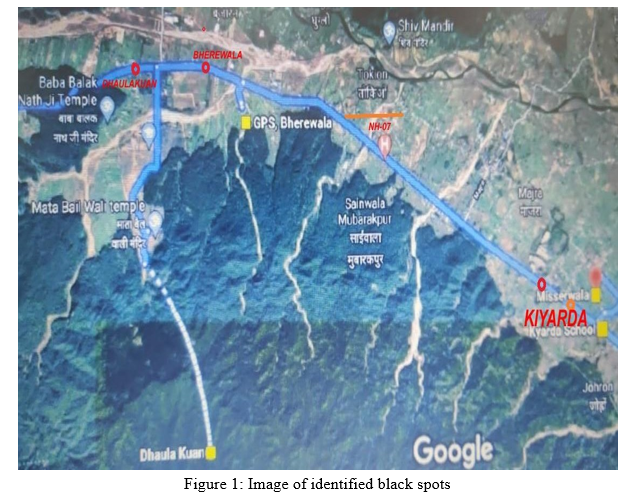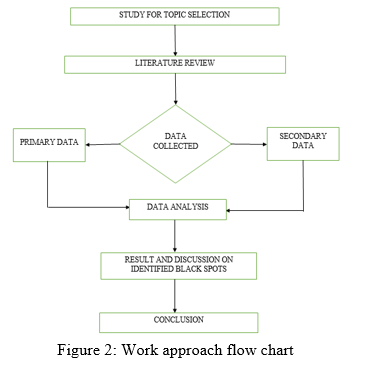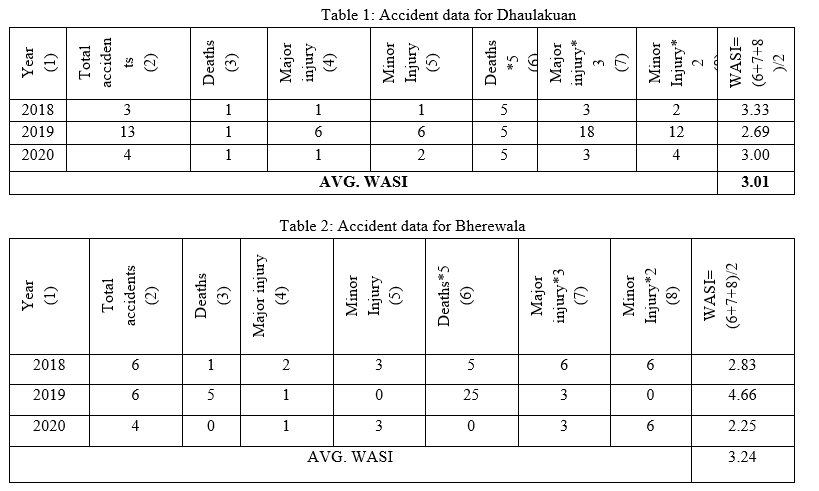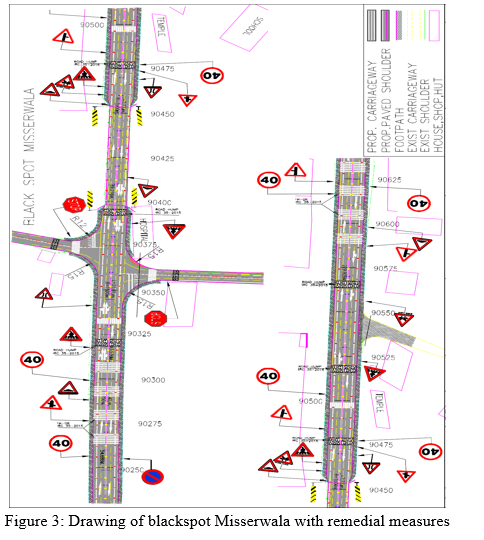Ijraset Journal For Research in Applied Science and Engineering Technology
- Home / Ijraset
- On This Page
- Abstract
- Introduction
- Conclusion
- References
- Copyright
Study on Identified Blackspots and Rectification Measures: A Case study
Authors: Surbhi Semwal, Ajay. K. Duggal, Dr. Sanjay K. Sharma
DOI Link: https://doi.org/10.22214/ijraset.2022.43200
Certificate: View Certificate
Abstract
In this paper, the survey was conducted in the Sirmour district of Himachal Pradesh where National highway 72 (NEW NH-07) runs through the district and other state highways connecting the state to the rest of the country. However, due to the district\'s abrupt bends, cliffs, and narrow streets, it has experienced the large number of traffic accidents. As a result, the study of the accident blackspots on this stretch is crucial for road safety. The study area lies between Dhaulakuan to Kyarda having a length of 9 km in the plain area has already identified 4 blackspots by police authorities and P.W.D. Department. The essential accident data of 4 years was collected to analyse the selected stretch. This paper deals with the identification of such accident black spots using the method Weighted Severity Index.
Introduction
I. INTRODUCTION
According to World Health Organization, deaths due to accidents is the 8th leading cause of death and the first largest of death among children having age 5-14 years and adult 15-29 years. In Himachal Pradesh, the road is the most common mode of transportation. Roads are Critical infrastructure for the rapid economic expansion of a state or nation.
In Himachal Pradesh, NH 72 (New NH-07) has a length of 57 km i.e., Kala Amb to Paonta Sahib. It passes through the district Sirmour and several state highways are making the state well connected to other parts, but high terrain and typical topography of the highways, limited lanes, sharp turns, reckless and intoxicated driving contribute to the devastation. The road section has been analyzed by the police department and PWD department as per road accidents and identified 13 nos. black spots. "Black spots" are areas that have more accidents than other similar sites on the road system, or regions with an accident number and/or rate higher than a preset minimum.
Accidents do happen on account of one or a mix of various factors such as:
- Weather conditions
- Road characteristics/ factors
- Driver behavior including violation of the traffic rules
- Vehicle condition
The primary goal of this research was to aid in the development of transportation security and the reduction of the impact of accidents and also to recognize the importance of safety in road design at identified black spots.
The committee of the concerned NH Division investigates the blackspot in concern to see if any deficiencies in road geometric design were to blame for the numerous incidents. After consulting the local police to figure out what's causing the accidents, different short and long-term strategies to limit the number of such incidents were implemented. Short-term solutions that include signs and markers should be implemented and long-term remedial treatment must first determine whether adequate land is available, and then the suggestions must be submitted for approval.
The selected location for the case study of identified black spots was on the NH-07 and the study area lies between Dhaulakuan to Kyarda having a length of 9 km in plain area and having an average width of flexible pavement is 10m with paved shoulders. In the project area police authorities and P.W.D. department has already identified 4 nos. blackspots as shown in Fig,1

A. Assessment Of Black Spots
Various methods to analyze blackspots are as follows:
- The Accident Severity Index Method: The blackspots are selected based on the severity of the site, and a road safety study was conducted in the hotspots that were discovered. It is a dimensionless statistic that indicates a location's hazard.
- The Accident Density Method: The average number of accidents per unit length is used to compute the specified number of accidents. High accident locations are defined as sections having more than a pre-set number of accidents.
- The Weighted Severity Index Method: The weighted severity index approach assigns points to accidents based on the number and severity of accidents in that area during the previous four years, and weight is assigned depending on the damage inflicted during the accident on a scale of 2 to 5.
- The Critical Crash Rate (CCR): A black spot is a section of the road network that is prone to traffic accidents and has a high frequency of collisions. The actual number of collisions at a given area is known as the site rate. Because accidents happen frequently and also rarely in some cases, we can't identify any accident-prone areas just based on accident data. It is also related to vehicle population. The Critical Crash Rate (CCR) approach is used in this section to calculate the crash rate at any site by including traffic volume.
II. SCOPE OF RESEARCH
To aid in the development of transportation security, reduction in impact of accidents, recognize the importance of safety in road design at identified black spots and to adopt the awareness of road safety for non-motorized as well as motorized road.
A. Objectives of study
The objectives of the study were the:
- To study the identified blackspot regions based on road accidental data on the particular stretch.
- To investigate different parameters of road accidents based on accidental data.
- Examine the safety elements used in the chosen section and identifying road network flaws that cause accidents.
- To suggest corrective measures as short-term and long-term remedial measure.
III. RESEARCH METHODOLOGY
The following steps was carried out for achieving the objectives of the research: -
- A stretch of NH 72(New NH 07) was selected for the study.
- Research papers were studied thoroughly for the knowledge of different methods and models used during the research and to get an idea about what data is to be collected. In this stage, primary data such as details of road inventory and secondary data such as accident data was collected from National Highway Division HPPWD Nahan, Himachal Pradesh.
- Analysis of collected data has been done. Then, after the analysis and discussion done on the identified black spots, remedial measures were suggested for the identified black spots.
- Lastly, interpretation of result and conclusion.

IV. RESULTS ANALYSIS
The results were obtained separately for the considered 4nos blackspots on NH 07 and were compared to find out the least and most accident-prone area.
A. Visual examination
The visual examination of existing road on NH07 was carried out to assess the present condition of roads. This inspection was conducted in the period between 2018-2020. Following deficiencies were found as follows:
- Intersections and signs were not clear and visible.
- Proper shoulders were not provided.
- The road has poor drainage.
- The speed zone was not safe and signed.
- Pedestrians were not able to cross the road safely.
- Absence of lighting poles in the medians.
- The road was not protected from local weather such as fog, storms, winds, etc.
- The road surface was not free of gravel, sand, and good skid resistance.
- Lane widths, shoulder widths, shoulder widths were not safe for traffic volume and mix.
- Crash barriers were not correctly and safely installed.
B. Secondary Examination
The accidental data of three years from 2018 to 2020 was collected such as total number of accidents, number of deaths and the type of accidents. This data was used to calculate the WASI value of the given blackspot. As a result, the blackspot would undoubtedly be detected.
The calculated WASI of 4nos blackspots are shown as below:



Based on the detailed study of secondary data and with the help of weighted accident severity index method we concluded that blackspot named as MISSERWALA has higher value of WASI i.e., 3.25 and blackspot named as KYARDA has least value of WASI i.e., 2.98. Thus, the WASI for all the four stretches (blackspots) is in very close range of nearly 3.0 to 3.25.
VI. FUTURE SCOPE
Proper remedial measures from IRC codes and MORT&H specifications are hereby suggested to reduce the road mishaps as the road infrastructure is important for growth of Indian economy in present times. These are applicable for all the four sections.
- Provide smooth paved shoulders.
- Crossings both near intersections and mid-block, raised pedestrian crossing should be made mandatory in case of multilane road with heavy volume of vehicular traffic.
- Crossing must be provided at all T-junctions.
- “At grade” pedestrian minimum 3m wide pedestrian crossing and 2.5m wide cycle crossing must be provided at all road crossings.
- Sign boards should be installed for psychological behavior of users which help in controlling rate of accidents.
- Speed humps with adequate marking should be provided.
- Provide mandatory and regulatory sign boards as per IRC:67-2012.
- Double stop line should be provided at junction.
- The reflective pavement markers (road studs) shall be provided to improve the visibility in night time and wet weather condition.
- Pedestrian lighting should illuminate the pedestrian walkway, appropriate lighting fixtures not exceeding a height of 4m from ground level should be provided.
- Light pole should be located within tree planting zone so that they do not interfere clearance of the main pedestrian walkway of footpath.
- Concrete pavement surface can be textured (tine textures or brush textures) for improving the skid resistance and also for quick surface drainage through tiny channels of textures.
- Installation of convex mirror and Providing rumble strips.
- Advisory speed limits at sharp bends and provide regular speed limits.
- Provide the guard rails.
- Widening of lane and providing overtaking lanes which can improve traffic flow.
- Footpath can also be provided at the bridge.
- We can provide RCC crash barriers (M40) for all bridges in Highway to safeguard against errant vehicles. (IRC: 21 - 2000).
- We can also install speed detecting devices.

Conclusion
The paper attempts to study the selected stretch, identify and analyze the pattern of accidents and various pattern of accidents and various parameters responsible for accidents in the study area i.e., NH07 stretch between Dhaulakuan to Kyarda. The weighted accident severity index (WASI) method was used to rank the blackspot area. The required data was collected from HPPWD department and RADMS. After analyzing and evaluating the entire data it was concluded that Misserwala had high WASI value i.e.,3.25 hence it was more prone to road accidents and major reasons for accidents on blackspots were poor visibility, unclear intersections, carelessness of driver, over speeding, narrow bridge, absence of pedestrian path, absence of crash barriers, lack of road markings, sign boards and zebra crossing and so proper remedial measures from IRC codes and MORTH were suggested and implemented to reduce the road accidents.
References
[1] Arun Kumar, Ajay Singh Chauhan, Abhishek Thakur, Khushpreet Singh and Aditya Tiwary “Black Spot Analysis on NH- 21A” Indian Journal of Science and Technology, Vol 9(44). [2] Myriam Marie Delcasse, Sharoon. “Black Spot Study” International Journal of Engineering Science and Computing, October 2017Volume 7 Issue No.10. [3] P. Puvanachandra, C. Hoe, H.F. El-Sayed, “Road traffic injuries & data system in Egypt: addressing the challenges” (2011). [4] Apparao G., P. Malikarjun Reddy &Dr. SSSV Gopal Raju, “Identification of accident Black Spots for National Highway using GIS” (2013) [5] Naidu V.M., Venkat L. & P. I. Vamsim, “Identification and analysis of black spots on NH-5 Visakhapatnam (India)” (2011). [6] B. Srinivas Rao, E. Madhu, Santosh Jalihal and TS Reddy (2005), “Accident study on NH-5 between Anakapalli to Visakhapatnam”, In the proceeding of the eastern Asia society for transport study Volume:5, pp. 1973-1988,2015. [7] Srinivasan, N. S.; Iyer, V. S.; Chand, M. and Srinath, K. (1987). “Scientific identification and improvement of accident-prone locations on national highways in Kerala, Journal of the Indian Road Congress, Vol.48 (3), pp.1-10. [8] Jayesh Juremalani, Fshatsyon Brhane Gebretensay, (2018) “Road Traffic Accident Analysis and Prediction Model: A Case study of Vadodara City”, International Research Journal of Engineering and Technology (IRJET) e-ISSN: 2395- 0056 Volume: 05 Issue: 01. [9] Anuj U. Manerikar, Snehal Bobade-Sora, Devika J. Buttepatil, Prem M. Rathod (April 2016), “Black Spots Analysis on Pune- Bangalore National Highway”, International Research Journal of Engineering and Technology (IRJET), Volume: 03 Issue: 04, pp. 1157-1160 [10] Sandeep Panchal and Lalit Singh Rawat (2017), “Pattern of Road Traffic Accident: A Case study of Hamirpur District In Himachal Pradesh (H.P)” International Journal of Mechanical Engineering and Technology (IJMET) Volume 8, Issue 2, February 2017, pp. 194–197. [11] Rajat Sharma and O. P. Mittal (2016), “Accident case studies causes and preventions measures for NH-1 India”, volume:3, issue:2, pp:193-196, 2016. [12] Nagarajan, M., and Cefil, M. (2012). “Identification of Black Spots & Accident Analysis on NH-45 Using Remote Sensing & GIS”, International Journal of Civil Engineering Science, Vol. 1, pp.1-7. [13] R. V. Jadhav, P.A Pisal, S. B. Hivrekar, S. S. Mohite (2017), “Identification and analysis of Blackspots on Islampur -Ashta state highway Maharashtra India”, International conference on latest Concepts in science technology and management, ICLCSTM-2017, pp:167-170, 2017. [14] Pavan R Vyas, Madan L. Honnappanavar, H Balakrishna (2015), “Identification of Blackspots for same commuting using WSI & GSI”, International journal of advanced structures & geotechnical engineering, volume:4, pp:47-51, 2015. [15] Shaik Salauddin, Reshma. E. K (2013), “Black Spots Studies on National Highway 209 Kanakpura Road Bangalore for A Stretch Of 15km” International Journal of Engineering Research & Technology (IJERT) Vol. 2 Issue 7, July – 2013 ISSN: 2278-018. [16] Tuenjai FUKUDAet.al. “Empirical Study on Identifying Potential Black Spots Through Public Participation Approach” A Case Study of Bangkok. Journal of the Eastern Asia Society for Transportation Studies, Vol. 6, pp.3683 - 3696, 2005. [17] A.M. Boroujerdian, M. Saffarzadeh, and V Abolhasannejad, (2010), “developing a model for prioritizing high crash road segment”. Proceedings of the institution of civil engineers- Transportation, vol.163, no.1, pp.19-29. [18] Avinash Kaur Khalsa, Dr. P.Y. Pawade, (2019), “Study on accidental risk analysis and preventive measures for road safety”, International Journal of Advance Research, Ideas and Innovations in Technology, ISSN: 2454-132X Impact factor: 4.295(Volume 5, Issue 3). [19] Dipali R. Khamankar et.al (2021), “Accident Analysis and Blackspot Identification at Chandrapur City”, International Journal of Scientific Research in Science and Technology Print ISSN: 2395-6011 [20] Annual report 2019-20 – MoRTH https://morth.nic.in/sites/default/files/Ministry%20Annual%20Report_2019-20 [21] Road Accidents in India - 2018, TRW, MoRT&H, as per latest published data. [22] \"Deaths Down By 22%, But Road Crashes Still Biggest Killer In Himachal\". Hindustan Times, 2022, https://www.hindustantimes.com/cities/deaths-down-by-22-but-road-crashes-still-biggest-killer-in-himachal/story ibBcJ3bpPX9TQot0fHkeeM.html. [23] IRC:67-2012-code of practice for road signs. [24] IRC:21-2000-standard specifications and code of practice for road bridges section. [25] IRC:35-2015- code of practice for road markings [26] IRC: SP:88-2019- manual of road safety audit
Copyright
Copyright © 2022 Surbhi Semwal, Ajay. K. Duggal, Dr. Sanjay K. Sharma. This is an open access article distributed under the Creative Commons Attribution License, which permits unrestricted use, distribution, and reproduction in any medium, provided the original work is properly cited.

Download Paper
Paper Id : IJRASET43200
Publish Date : 2022-05-24
ISSN : 2321-9653
Publisher Name : IJRASET
DOI Link : Click Here
 Submit Paper Online
Submit Paper Online

